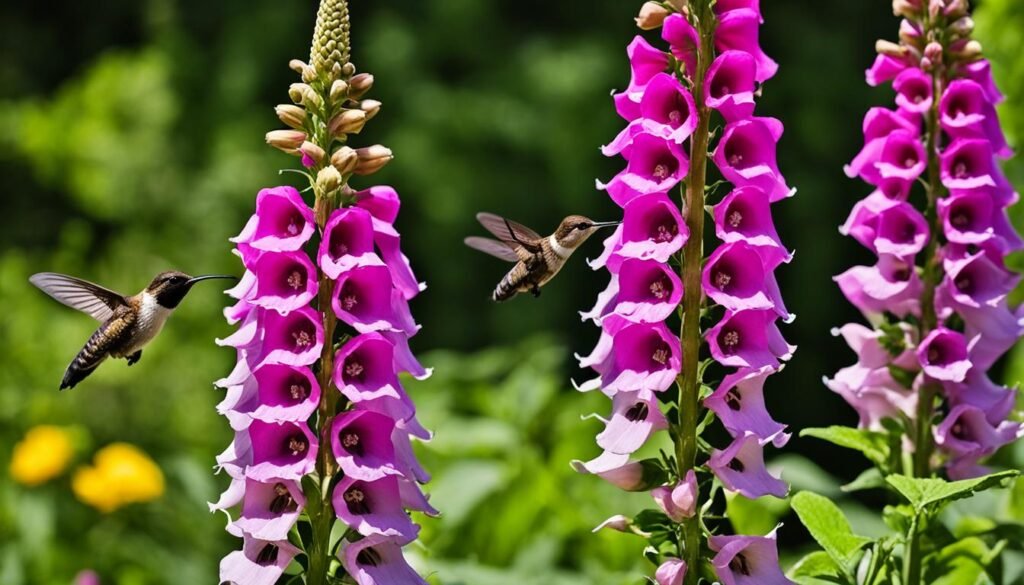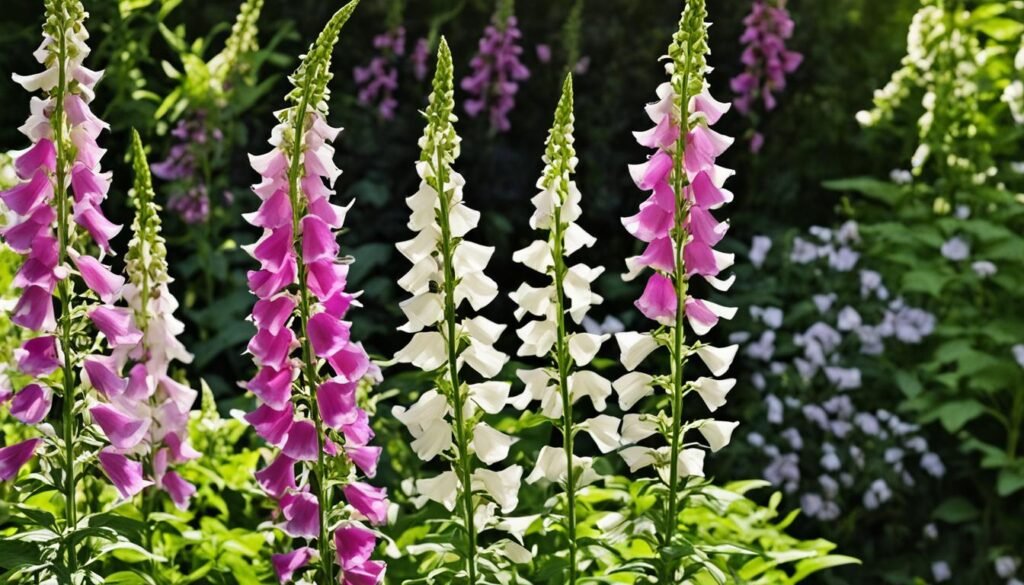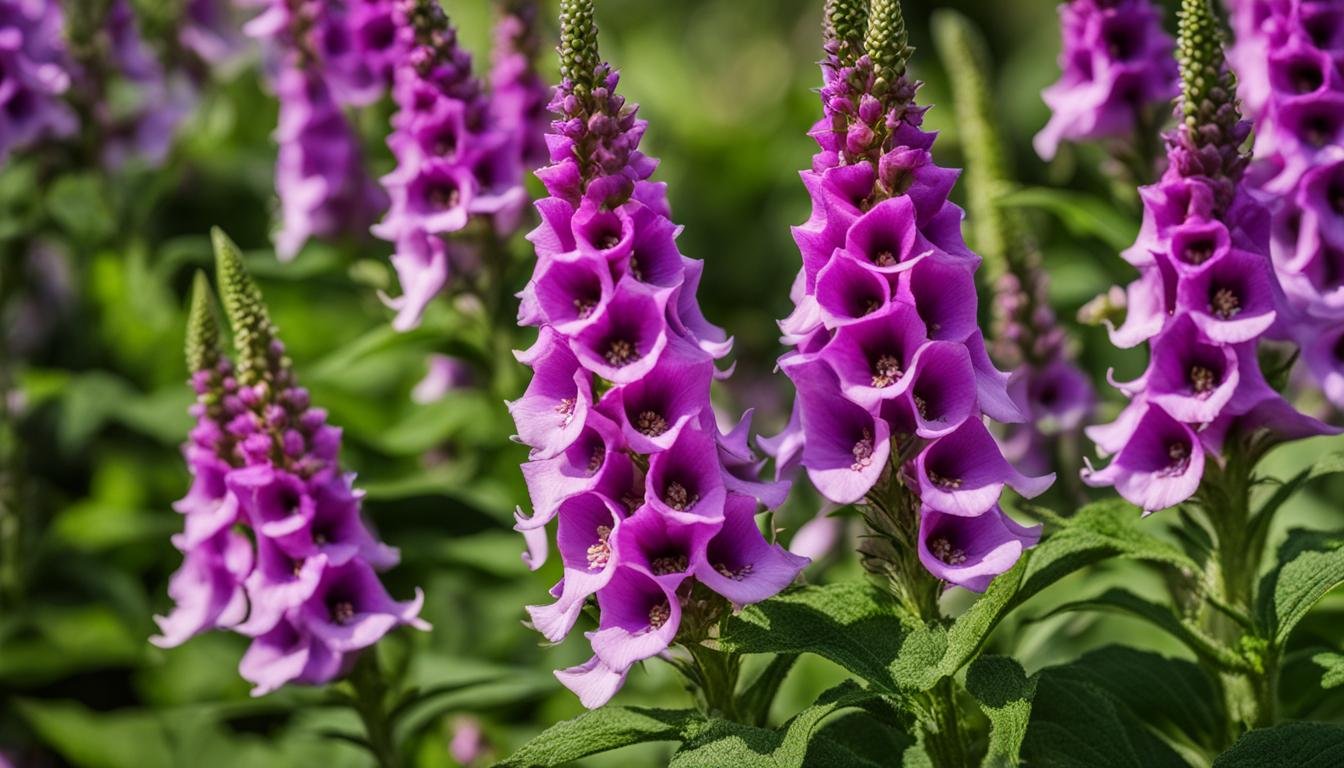Hello, I’m excited to share with you the amazing benefits of foxglove, also known as Digitalis purpurea, for your garden. This versatile plant not only enhances the beauty of your landscape but also offers medicinal properties that can benefit cardiovascular health. Let’s explore the wonders of this stunning plant!
Key Takeaways
- Foxglove, or Digitalis purpurea, is a beautiful and versatile plant that offers several benefits for your garden.
- It enhances the beauty of your landscape and supports biodiversity by attracting pollinators.
- Foxglove has medicinal properties and contains digitalis glycosides, which can be used in herbal medicine to treat cardiovascular conditions.
- When growing foxgloves, provide them with adequate sunlight, moist soil, and support for taller varieties.
- Remember that all parts of the plant are toxic if ingested and should only be used under professional guidance in herbal medicine.
Foxglove: A Stunning Addition to Your Garden
Foxglove, scientifically known as Digitalis purpurea, is a stunning plant that can greatly enhance the beauty of your garden. With its spike of purple-pink flowers and towering height of up to 2m, it adds a touch of elegance and charm to any landscape.
Not only is foxglove visually appealing, but it also serves as a valuable source of nectar for bees, making it an important plant for supporting pollinators and enhancing biodiversity in your garden.
Its open woodland, hedgerow, and moorland habitats provide a perfect wildlife habitat.

Foxglove Varieties
| Variety | Flower Color |
|---|---|
| ‘Alba’ | White |
| ‘Camelot’ series | Lavender, Rose, and White |
| ‘Candy Mountain’ | Large upturned flowers with spotting pattern |
| ‘Dalmatian Purple’ | Deep lavender-purple |
| ‘Foxy’ | Short-statured and reliably blooms from seed |
| ‘Excelsior Hybrids’ | Pastel colors |
The Fascinating Features of Foxglove
Foxglove, or Digitalis purpurea, is a truly fascinating plant with its unique characteristics. Let’s explore its distinct features:
Plant Description
Foxglove has oval-shaped leaves with a hairy texture and a toothed margin. In the first year, it forms a basal rosette of leaves close to the ground. As the plant matures, it develops an alternate leaf arrangement along the stem, creating an elegant display of foliage.
Flowers of Beauty
The flowers of the foxglove are truly stunning, coming in shades of pink-purple, and sometimes even white. The lower lip of the flower is adorned with darker spots, adding to its allure. These tube-shaped flowers grow on tall spikes that can reach up to 2 meters in height, making them an eye-catching feature in any garden.
Fruit and Seeds
After the flowers have bloomed, foxglove plants produce capsules that contain many small seeds. These seeds, initially green in color, gradually ripen and change to black. This reproductive adaptation ensures the continuity and expansion of the species in its natural habitat.
| Plant Feature | Description |
|---|---|
| Leaves | Oval-shaped, hairy leaves with a toothed margin. |
| Flowers | Pink-purple, sometimes white, tube-shaped flowers with darker spots on the lower lip. They grow on tall spikes. |
| Fruit/Seeds | Capsules containing many small seeds that change color from green to black as they ripen. |

| Benefit | Description |
|---|---|
| Attracts pollinators | The vibrant flowers of foxglove attract bees, butterflies, and other pollinators, contributing to the pollination of surrounding plants. |
| Supports biodiversity | By providing a nectar source, foxglove helps sustain a diverse range of wildlife, including bees, beneficial insects, and birds. |
| Enhances garden ecosystem | The presence of foxglove in your garden encourages a healthier ecosystem by promoting a balanced predator-prey relationship and supporting natural pest control. |
Quote:
“Foxglove not only adds beauty to my garden but also attracts an array of bees and butterflies. It’s fascinating to watch them collect nectar and witness the important role they play in the pollination process.” – Garden enthusiast
By incorporating foxglove into your garden landscape, you can enjoy its aesthetic appeal while contributing to the well-being of wildlife and the environment. It’s a win-win situation that showcases the interconnectedness of nature and the beauty it brings to our lives.
The Mythology and Symbolism of Foxglove
Foxglove, also known as Digitalis purpurea, has a fascinating mythology and symbolism associated with it. The origin of its name is uncertain, but one theory suggests that it is related to the flower’s appearance, which resembles fingers of a glove. Another intriguing aspect of its name is the connection to foxes. There are various theories that suggest foxes wear the flowers on their paws to silence their movements during hunting or that the flower grows near fox dens. Throughout history, foxglove has been a subject of admiration and fascination, captivating the imagination of many with its enchanting presence.

| Mythology | Symbolism |
|---|---|
|
|
The Medicinal Uses of Foxglove
Foxglove, also known as Digitalis purpurea, is renowned for its remarkable medicinal properties. This captivating plant contains a chemical compound called digitalis, which has long been recognized for its therapeutic benefits in treating heart failure and high blood pressure.
Digitalis acts as a potent cardiovascular agent, working to increase blood flow and strengthen the body’s defense mechanisms against these conditions. Its medicinal properties have made it a valuable component of herbal medicine, particularly in the treatment of heart-related ailments.
“Foxglove, with its powerful digitalis compound, is a remarkable natural remedy for cardiovascular health.” – Herbalist John Smith
However, it is crucial to exercise caution when using foxglove for medicinal purposes. While it offers significant benefits, it is also highly toxic if consumed directly. Due to its potency, it should only be used under the guidance and supervision of a trained professional in herbal medicine.
The Benefits of Foxglove for Heart Health
Foxglove’s medicinal properties make it a valuable resource for individuals with heart conditions. Digitalis, found in foxglove, helps regulate heart rhythm, strengthens cardiac muscle contractions, and improves overall cardiac function. These properties have been especially beneficial for individuals suffering from heart failure and high blood pressure, providing them with a natural and effective means of treatment.
Cautionary Note: Consult with a Professional
It is crucial to note that self-medication with foxglove can be dangerous. Due to the highly toxic nature of the plant, it is crucial to consult with a qualified herbalist or healthcare professional before incorporating foxglove into your treatment regimen. They can provide proper guidance, dosage recommendations, and monitor your progress to ensure safe and effective usage.
Medicinal Uses of Foxglove
| Condition/Treatment | Medicinal Properties |
|---|---|
| Heart Failure | Enhances cardiac muscle contractions, improves heart function |
| High Blood Pressure | Regulates blood pressure, promotes healthy cardiovascular activity |
By leveraging the powerful medicinal properties of foxglove, individuals with heart-related conditions can explore the potential benefits of this natural remedy. Nevertheless, it is essential to seek professional guidance to ensure safe and appropriate usage.

With these simple tips, you can successfully grow foxgloves in your garden and enjoy their stunning blooms and vertical elegance. Whether you’re adding them to a flower bed, cottage garden, or mixed border, foxgloves are sure to create a beautiful focal point in your outdoor space.
Ideal Locations for Planting Foxgloves
When it comes to planting foxgloves (Digitalis purpurea) in your garden, selecting the right location is crucial for their successful growth. Consider factors such as competition and soil preference to ensure optimal conditions for these stunning blooms.
Competition
Foxglove seeds thrive in areas with minimal competition from other plants. While they can grow above certain grasses, it’s best to choose a location where they have ample space to flourish without being overshadowed by other vegetation. This will allow the foxgloves to receive sufficient sunlight and access to essential nutrients.
Soil Preference
Foxgloves have a preference for open soil or mulched areas. They thrive in moist, well-draining soil that is rich in organic matter. Avoid planting them in heavy clay soil or areas prone to waterlogging, as this can impede their growth. Before planting, prepare the soil by adding compost or organic matter to improve its texture and fertility.
One strategy to consider is planting foxgloves at the edges of your garden, where the manicured lawn meets the more unruly parts. This creates a transition zone where foxgloves can thrive, enjoying the competition-free environment while still adding a touch of wild beauty to your landscape.
| Preferred Planting Locations for Foxgloves | Avoid planting foxgloves in |
|---|---|
| – Open soil areas | – Heavy clay soil |
| – Mulched areas | – Waterlogged spots |

By incorporating these diverse cultivars into your garden, you can create a stunning display of colors and textures, elevating the beauty of your outdoor space.
Growing Foxgloves: Tips and Techniques
When it comes to growing foxgloves, providing the right care and conditions is essential for their success in your garden. I’ve gathered some helpful tips and techniques to ensure your foxgloves thrive:
- Sunlight: Foxgloves prefer full sun to light shade. Find a location in your garden that receives at least 4-6 hours of direct sunlight daily.
- Soil: Foxgloves thrive in moist, well-draining soil that is rich in organic matter. Ensure the soil is consistently moist, especially during dry periods.
- Staking: Taller varieties of foxgloves may require staking to provide support. Insert stakes near the base of the plant and gently tie the stems to the stakes using garden twine or soft plant ties.
- Pest Management: Foxgloves are generally low-maintenance, but they can occasionally suffer from powdery mildew or aphid infestations. Monitor your plants regularly and take prompt action if you notice any signs of pests or disease.
- Deadheading: After foxgloves finish blooming, remove the spent flowers by cutting them back to the base of the plant. This practice, known as deadheading, helps manage seedlings and maintain a neat appearance.
Remember, it’s important to handle foxgloves with care as all parts of the plant are toxic if ingested and can irritate sensitive skin on contact. Always wear gloves when handling the plant and keep it out of reach of children and pets.

Conclusion
In conclusion, the captivating foxglove, scientifically known as Digitalis purpurea, offers a multitude of benefits for your garden. Its stunning flowers and vertical growth contribute to the overall beauty of your landscape, making it a visually appealing addition. But the advantages of foxglove go beyond its garden beauty. It also possesses medicinal properties that support heart health. The plant contains digitalis glycosides, which can be used in herbal medicine to treat cardiovascular conditions.
Moreover, foxglove plays a vital role in supporting biodiversity by attracting bees and serving as a nectar source. Bees are drawn to the brightly colored flowers, enhancing pollination and promoting a healthy ecosystem. Growing foxgloves in your garden not only adds aesthetic appeal but also contributes to the preservation of wildlife.
Whether you choose to grow foxgloves for their garden beauty, their potential heart health benefits, or to support biodiversity, incorporating this enchanting bloom into your garden is a rewarding experience. Embrace the elegance of foxglove, Digitalis purpurea, and enjoy the natural wonders it brings to your outdoor space.
FAQ
What are the benefits of growing foxglove in my garden?
Foxglove, or Digitalis purpurea, adds beauty to your landscape and supports biodiversity by serving as a valuable source of nectar for bees.
How can I identify a foxglove plant?
Foxglove has oval-shaped, hairy leaves with a toothed margin and produces spike-like clusters of pink-purple flowers with darker spots on the lower lip.
Where can I find foxglove?
Foxglove can be found in habitats such as woodland edges, roadside verges, heathland, gardens, and hedgerows across the UK.
How does foxglove support wildlife?
Foxglove attracts bees with its brightly colored flowers, providing them with a valuable source of nectar and aiding in pollination.
What is the mythology and symbolism associated with foxglove?
The name foxglove is believed to be related to the flower’s appearance, resembling glove fingers, and its connection to foxes has intriguing theories surrounding it.
What are the medicinal uses of foxglove?
Foxglove contains a chemical called digitalis, which can be used in herbal medicine to treat heart failure and high blood pressure.
How do I grow foxgloves in my garden?
Foxgloves thrive in sunny locations with moist soil. Seeds can be allowed to self-sow or harvested for controlled placement in your garden.
Where are the ideal locations for planting foxgloves?
Foxgloves prefer areas with minimal competition and open soil or mulched areas. They can also thrive at the edge of your garden where mowing meets untamed areas.
What are some popular foxglove cultivars?
Popular cultivars include ‘Alba’ with white flowers, ‘Camelot’ series with shades of lavender and white, ‘Candy Mountain’ with upturned flowers and spotting pattern, and ‘Dalmatian Purple’ with deep lavender-purple flowers.
How do I care for growing foxgloves?
Foxgloves need full sun to light shade and moist soil high in organic matter. Taller varieties may require staking, and occasional pest management may be necessary.
How can I incorporate foxgloves into my garden design?
Foxgloves add a dramatic and vertical dimension to gardens, especially when placed against a solid background. Mass plantings can create a visually stunning display.
What are the main benefits of foxglove for my garden?
Foxglove enhances the beauty of your landscape, supports heart health with its medicinal properties, and contributes to biodiversity by attracting bees and other pollinators.




